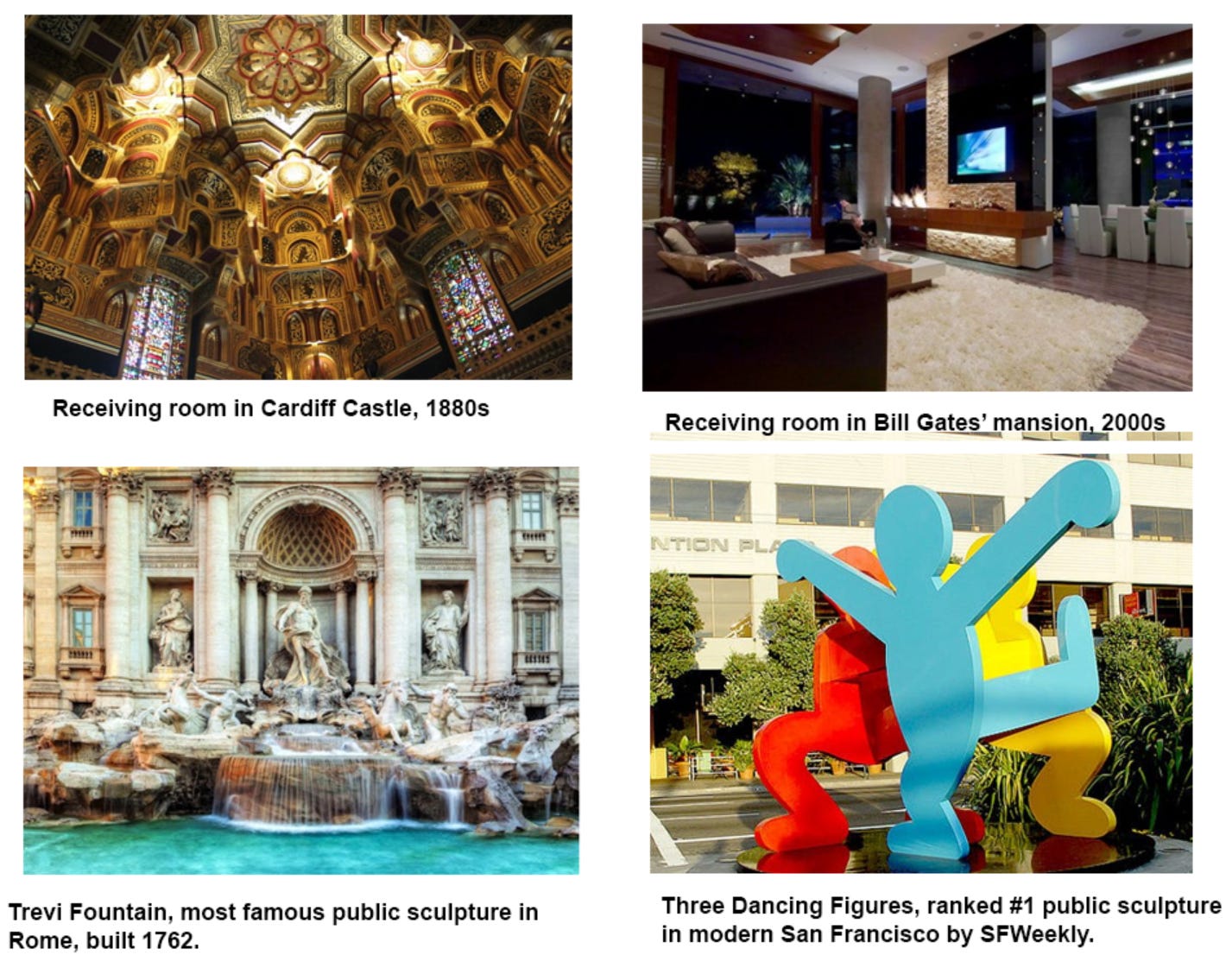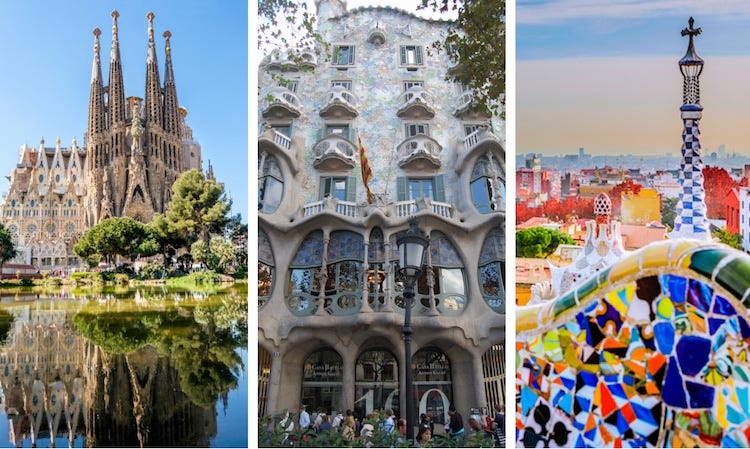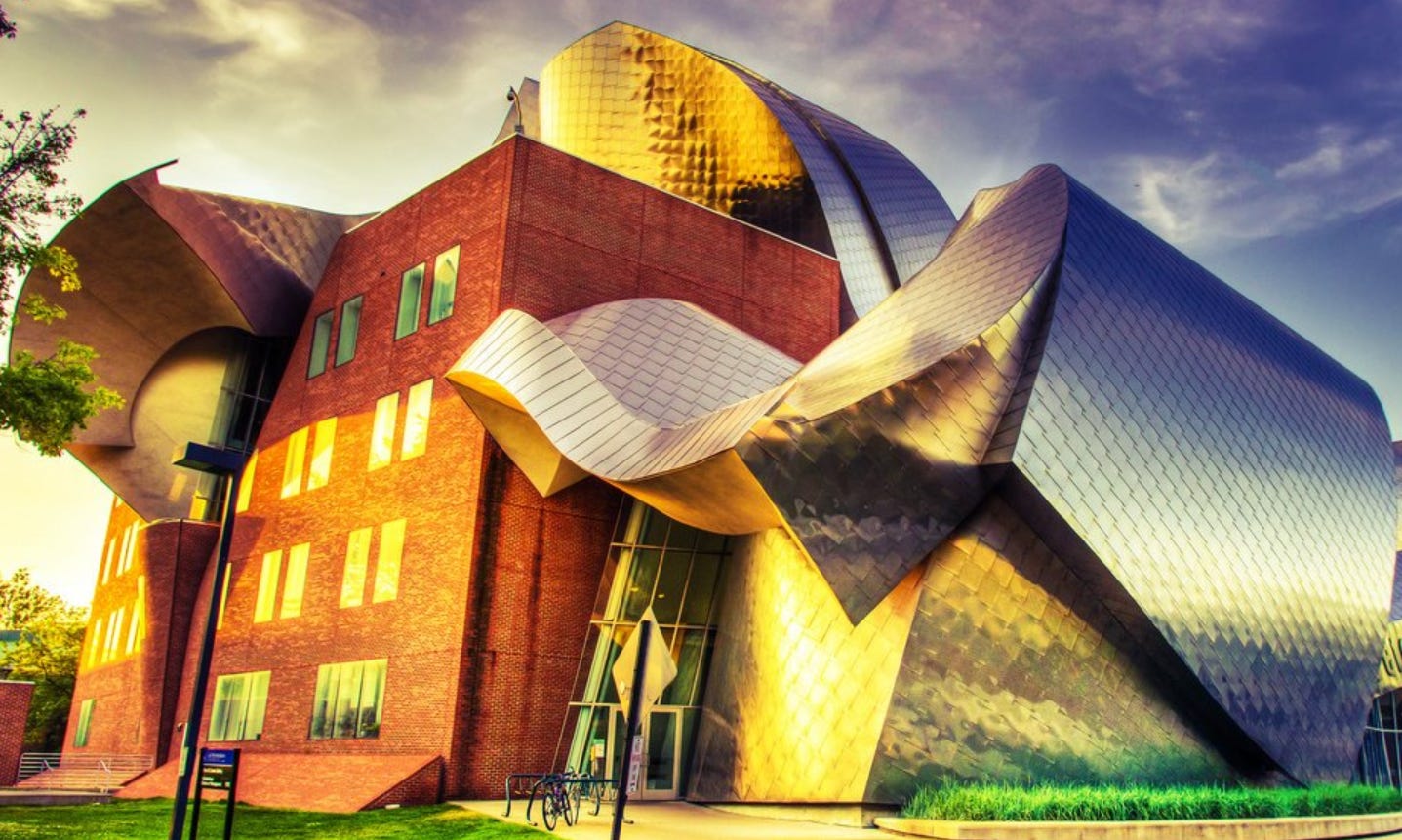The Unbearable Lightness Of Beauty
How progress in art and architecture is alive and well!
My toddler’s favourite place in London is the Natural History Museum. It’s one of the best examples of Romanesque architecture, and is an extraordinary work of art by any stretch of imagination. The museum however, also expanded and added a Darwin Center (below, right), which is decidedly … boring. Despite being great conceptually (its in the shape of a cocoon from which knowledge can emerge). Its architectural beauty, such as it is, makes it generally accepted as the ugly sibling. The question is, why?
There's a strain of thought that asks why modern art and architecture is so ugly, compared to the ancients. ACX has an article on a conspiracy theory that notes this as a key piece of evidence of cultural decline! While the premise seems obviously silly - e.g, Tartaria was an ancient superpower that allowed us to build amazing things, now lost to time - they seem compelling enough to a small group of enthusiasts (r/tartaria has 11k members, 5x lower than my favourite conspiracy theory at r/flatearth).
I thought it a bit of harmless fun when Scott had his tongue in cheek article which seemed to wink-wink agree with the theory, but the core assumption seems to have a fair few adherents, and some high profile supporters.
But they seem to ignore a wide variety of extraordinary art and architecture that exists around the world. And I cannot emphasise enough how much I disagree with this notion of cultural devolution, of the belief that we've regressed in art, music, poetry and architecture.
We live in a true age of wonder! So why do we constantly have this hum of dissatisfaction in the background? Of feeling like somehow we're being gypped by the cultural mores of the day? My theory.
We see the best creations of the ages past, and the average creations of today; the meaning and utility of these creations have changed over time
The capability of the artists has not decreased, we just produce a much wider variety of art today
We continue to make classical buildings, nobody is all that impressed by it anymore, and there is no easily comparable standard of excellence
We see the best creations of the ages past, and the average of today...
To start with the same article, when we compare the Trevi fountain with Three Dancing Figures in San Francisco, we're looking at the best of what existed in the ancient world, with an average fountain that exists in a small city today.
Trevi is not just "a great fountain in Rome". Its the best example of a fountain built bringing water from an ancient aqueduct commissioned by the Pope to be dramatic! It was specifically built to be beautiful, a spectacle, a marvel.
San Francisco, by comparison, is none of those things. And SFWeekly is not the best judge, I'd wager, of what will be considered iconic in a few centuries.
Similarly, Cardiff Castle wasn't "the receiving room of a rich person". When it was built 700 years ago, and rebuilt 600 years ago, it was the main domicile of a king! Later on it was the domicile of an Lord! It was a symbol of power, of plenty, of the majesty and might of the one who governed the island. Even with all of that, the castle was transformed into a Georgian mansion in the 19th century when the owners got rich.
And Bill Gates' living room is none of the above. It is not a state-room. It is not a quasi-public space. It is not to showcase his wealth and prowess. It is for his comfort, not for public consumption. Bill Gates is many things, but he's not mansion constrained.
Here we're looking at the best examples from history against average examples of today. That's just not a fair comparison. Over the centuries, many fountains have come and gone. Many mansions were built and destroyed. We see what our collective ancestors felt worth preserving.
... The meaning and utility of these creations have changed over time
The Cardiff Castle is a castle because it had defensive purposes. It had to be able to defend its occupants from invading armies. While the advent of mortar made castles themselves less relevant later on, their purpose guided the construction.
We haven't yet reached that stage where Bill is fighting invading armies. When he needs it, I'd guess his living room stops being a private hideaway and a public receiving room, where he actually conducts his daily work and business. If he was granting audiences and trying to impress them with his house, things would be different.
Similarly fountains aren't as central to us as they were for the Romans. Clean water isn't a miracle, and as awesome as aqueducts are in bringing water from far and wide, we've far surpassed them in most ways. Our waterways are larger, longer and the water is cleaner. That’s why we don't need to wonder at fountains as marvels of modernity, and they're not destinations any longer.
Art and music are similar. As they've gotten easier to produce, they have devolved their enjoyment aspect from the class-status-identification aspect. This means that a piece of music today is not simultaneously trying to be high art and sound good, but can focus only on one or the other.
There was a time when paying artisans to create ornamentation around your house would've been a rather reliable indicator of your wealth and taste. Today it isn't. You could get a pretty great Michaelangelo knockoff painted on your ceiling by a good art student, of whom there are thousands.
Also, as someone who lives in a rather picturesque old Tudor style London house, I can tell you from experience that while the wisteria outside looks incredible, the house itself is way less comfortable than the modern glass box 8th floor apartment I lived while in Singapore.
The capability of the artists has not decreased...
But surely, we haven't had a Michaelangelo since Michaelangelo? Someone who can bring realism and an eye for wonder, to sculpt beauty from a block of marble.
So I looked at a random sample of modern realistic sculptures, and found a large movement of hyper-realistic and realistic sculptors around the world. My favourite one is below, of a baby elephant in utero.
In Michaelangelo's time realistic sculptures were difficult to achieve, and he had complete mastery. But it seems that we're able to reach heights of such ability today as well. I'm not making an aesthetic comparison that these are as good as Pieta, but surely we can agree that the realism is at par. And the imagination might be of a different calibre, but that's also because we're not living in a dominant monoculture where what's great isn't well known by everyone. Or even by all the elites!
Similarly, we can argue which era exactly Gaudi lies in, but it's most definitely not the standard of classical beauty!
And whatever you think of Gehry, some of his creations are masterpieces by any stretch of imagination! Same for Zaha Hadid.
And for the dozens of other incredible architects who built these skyscrapers that inspire awe! The loop is a design proposed today and I'd wager it's as bold as anything we've done before.
That last one is a frickin' waterfall on a frickin' skyscraper. There is no world in which the architects today are less smart/qualified compared to the olden days!
... We just produce a much wider variety of art today
Let's start with architecture. After the revitalisation of the Victorian styles, resulting in beautiful buildings like the St Pancras Station in London, we now have a dizzying array of styles - Expressionist Architecture, Art Deco, International Style, Bauhaus Modernism, Post-Modernism, Futurism, Neo-Futurism and so on and on. There's brutalist modern monstrosities, there's the modernist glass palaces that look great if supremely uncomfortable, there's the hyper opulent palaces, the skyscrapers in multiple styles that actually touch the sky.
We have brick cooled homes and penthouses with hanging pools. We have ugly boxes and glass pyramids and monuments that do little else but make us wonder at the science that made them.
And meanwhile, in the world of art, not only do we have more experimentation and more styles, we've unlocked entire new mediums that let us create things that would've been unimaginable at any time past. We have realism, hyperrealism that tries (though I don't get why) to outdo photography, cubism, pointillism, and the staggering quantity and quality of digital art that takes my breath away!
So if you value convenience you might try to include items that solve for it than add another caryatid for shits and giggles.
The same is true for everything. Books, we have an enormous array of subjects and titles. Authors are more diverse than they've ever been and within each group they're fantastic! Music, whatever you feel about particular genres, it's gotten crowded enough that I can barely figure out what to search for in Spotify. Poetry might be dying, but at least with songsmiths we have both Bob Dylan and Kanye. Opera is dead but I can't muster up too much sadness about it since we have TV and movies, that too with CGI!
Within this land of plenty, to have the gall to suggest that somehow we don't like it enough to rhyme or paint or build ostentatious ornamentation is just simply not true. We do, but the variety in which we explore these wants is large enough that you can always look over your shoulder to point out someone building something you consider distasteful.
We continue to make classical buildings, nobody is all that impressed by it anymore ...
Exhibit A: Casa Loma
Exhibit B: Hearst Castle
Exhibit C: Boldt Castle
They are all magnificent. There are plenty more! They just don't bring the same awe because they weren't designed in the 1200s and have the weight of history behind them. As someone who absolutely loves the Hearst Castle it pains me to say this, but it's true. That's on us!
... and there is no easily comparable standard of excellence
The observation goes that elites and the plebs don't seem to agree nowadays as they seemed to have in the past. But whether that's because they just didn't have the sheet variety of styles as we have now, or because we only know what their standout dominant style was after a few centuries have passed, or because nobody really asked the plebs in the past what they liked in much detail, I don't know. What I do know is that in most ways we're at least the equal if not better.
We live in an age when styles spread faster than ever, which means the spread both grows and dies faster. But we still had decades of rock, rap and pop, each with the highest highs comparable to the masters of yore. We've had multiple architectural schools thrive, where we sculpt entire Hindu temples like before (e.g., in Birmingham or in Malibu), where we create Burj Khalifa, mega churches and underwater hotels.
Since building things by itself is easier these days, we've made artistic examination distinct from utility. After all, if you know that you can build multiple giant stadiums, you don't need to have a Colosseum.
What I'm arguing is that the current state of the art does delight more people than before, it just feels like it doesn't because there are way more of us. Our culture is richer and more varied, and the choice also leads to there not being one dominant view.
In absolute numbers I'm sure we have more elites and more non elites who love each style. Look at what they built from scratch in Putrajaya.
Or the cities built from the desert in Saudi Arabia. Yeah they're not part of the modern Western experience, and we're not likely to see these things built anytime soon in San Francisco. Aesthetic is informed by utility and availability, twas always thus.
What's different is that the styles prevalent today aren't easily comparable to each other, because they belong to different genres as often as not. Zaha Hadid's convention center and Wright's Fallingwater aren't easily comparable to say who's better. They're fundamentally different. And that makes it harder for us to crown one particular person.
When we visit St Peter's Basilica we can compare its grandeur and style to the Duomo of Florence and St Paul's in London. They have self similarity and continuity enough that we can compare and contrast. But look at those skyscrapers above, or those architectural marvels in the form of museums and concert halls - they're functionally different and therefore they are architecturally diverse.
Conclusion
So the only options for why this observation seems to get traction from smart people who generally are hyper-aware of progress, both technological and cultural, have to be one of the following.
Things are not as awesome as they were before (which clearly seems wrong)
Things are equally as awesome, just not part of the mainstream culture (which also clearly seems wrong)
Things are equally as awesome, but there are way too many types of art and architecture so there's no 'winner'
Things are equally as awesome, and part of the mainstream culture, just not in the West
#3 and #4 are closer to the answer. We have a lot of mainstream and substream cultures all around the world, complex enough that there's often no clear winner. And since there isn't a clear global winner we think we are somehow less cultured. But that isn't true, we just have a lot of artists. The sheer variety we have today means that a Schelling point amongst the entirety of the elites (were there such a thing) is much harder to achieve!
We're also not not producing art that doesn't evoke the same feelings as the past. We absolutely are. We're both ignoring the fact that the vast majority of the population (a larger majority than today) were completely irreverent towards that day's high art, and preferred to see a circus where they displayed exotic species in glass jars.
We want our art to have meaning. And history is ready made meaning. So the answer to why do we like the classical styles more than modern is, we don't. Not really. Many of us could afford to add a Doric column to our houses, but we choose not to. I'd argue the revealed preference here speaks volumes.
We should be celebrating this diversity, not lamenting that we don't still build the same crenellations into our castles and caryatids into our columns. We do so much more today because we can do so much more. Modern art is awesome. There's a lot of it and you have to work to see what you like. That's not a bug, that's a feature.
















A very interesting topic!
It seems to me that the age of information, which leads to a "threading" of culture, also inevitably scatters that culture to too many pieces for the common individual to follow.
Of course, every area and topic and sub-topic and so on also gets expanded and raised to new heights by the artists who take interest in them. That's the nature of the digital plane, it's like open source culture, for culture.
Don't you think a culture can be too decentralised? I can't see how we, as a collective, will be able to appreciate art together like that - like we maybe used to do, though I'm too young to be sure.
It also seems like currently it's relatively easy to satisfy your hunger for art if you have interest in the first place. But outside of monoculture, maybe those who have no taste for art, have a harder time to acquire it.
I broadly agree, just a correction: the fountain of trevi was built way after the fall of the Roman empire. It's more Enlightment era - although probably not very enlighted in Rome where the pope ruled.